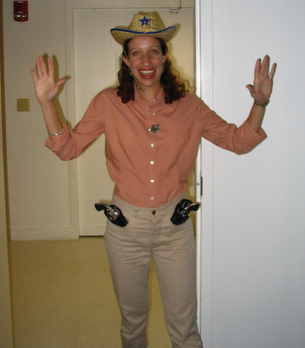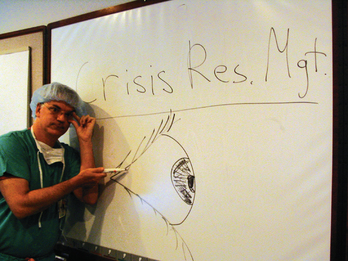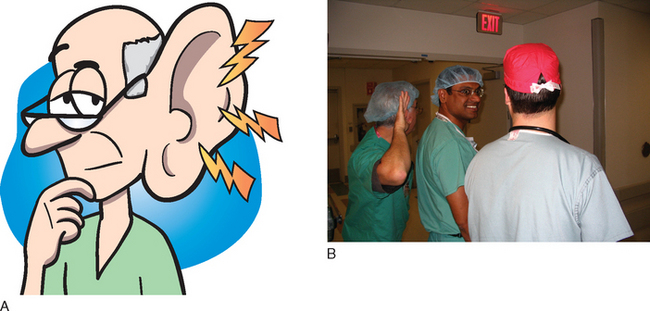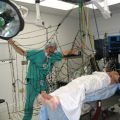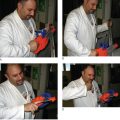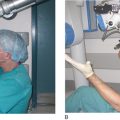CHAPTER 2 How Anesthesia Simulation Is Done
A CONFERENCE, INTERRUPTED
“This is for an adult, this is too big!”
“Get the blood bank on the phone!”
“Suction, suction, where’s the Yankauer?”
“This is asystole, someone feel a pulse, do you feel a pulse?”
“Forget that, how do we put his head down!”
“This light is out! Get me another one!”
You go over to the baby and try to intubate when the cop says, “Wait, her kid was in here to get a peanut removed from his ear. He didn’t get shot!” Then, on looking back, you notice that there actually isn’t any blood at all on the baby’s blankets, though you could have sworn there had been.
“Oh man, can you believe that?”
“I thought everyone was shot!”
“I went right to the airway, but then he talked!”
“With that guy in asystole, do we bother or just bag it?”
“Mass casualty drill, I was thinking, but didn’t they say a lot of people were shot?”
“No, did he actually say that?”
“Who were those people in there? I know the cop was a cop, but the other ones?”
“So, how do you think it went?” the first instructor asks.
“I didn’t know the equipment!”
“Was I supposed to take charge? I mean, I don’t even know these people.”
“It’s hard to know where to go first.”
You and your co-learners respond to the scene that just played out:
“Yeah, oh man, was it ever confusing in that ER!”
“Who’s dead, who’s passed out? What’s going on?”
This last method, the “good judgment” method, is the best way to ask questions during a debriefing.
After a few minutes, we flesh out our “+, delta” columns.
“To understand better what happened, why don’t we see what happened?” the first educator asks.
Roll tape, and oh my God but the camera does indeed throw an extra 10 pounds on you.
No matter how “in control” you might have thought you were, the tape shows just how random and maniacal you actually do look. Overlaid vital sign screens show stuff you simply didn’t notice. A minute of asystole before you do anything.
| Plus | Delta |
|---|---|
“It’s like the dashboard cam on COPS,” the first educator says.
“We’re busted,” one of your co-simulatees says.
“We’re not here to pin the tail on the donkey. We are here to see:
“In other words, we’re back to “Every event is a mystery to be solved, not a crime to be punished.”
“What movie was playing in our heads?” the first instructor says.
Another person says, “Pneumothorax, blood loss, tamponade. All the stuff that kills you fast.”
In the “clinical” arena, most of us feel in our “element.”
These are the principles of “crisis resource management”—an entire field of study. (Entire textbooks are written on the subject.) Crisis resource management originally looked at how crises are handled in airline cockpits, nuclear reactors, and the chemical industry. For example, before a plane crash, no one challenged the pilot about how low he was flying (no one stepped back and did a global assessment of the overall flight). At Chernobyl, no one reacted fast enough when the reactor started to overheat (no one knew of other resources available for cooling). In the Bhopal chemical spill, no one took charge of the safety mechanisms (there was no role clarity in the Dow Chemical Company’s safety department).
The other thing you want to do is assign people to either a “doing” job or a “thinking” job.
Figure out who can do what for you. The cop can’t intubate, but he can usher the distracting mother away. The anesthesiologist can get you an airway and a big line, so do not ask him (or her) to deliver the blood sample to the lab.
Not exactly a case of volume resuscitation.
“Wait, this second guy is OK. No blood on him, and his pulses are strong.”
“Same with the kid, he’s free of blood, is breathing, no trauma here.”
(Good time to re-verbalize, update the room.)
That’s global assessment. Ongoing, never static.
“OK, what do we take away from this,” the second educator asks.
“Well,” one colleague says, “we need to talk to each other more clearly.”
Here, then, are the major steps of the debriefing in review.
You go over the feelings of the participants. No matter how well prepared or educated, anyone gets a little “rattled” by the simulation scenario. That “rattling” is a critical part of the process. To propel learning, you need to create a little emotional “irritant.” For analogies, look to physical exercise: You tear down your muscles a little at the gym, then the muscles repair themselves, and you get bigger muscles. Another analogy is the sand grain that irritates the oyster. Give it enough time, and that irritant turns into a pearl.

